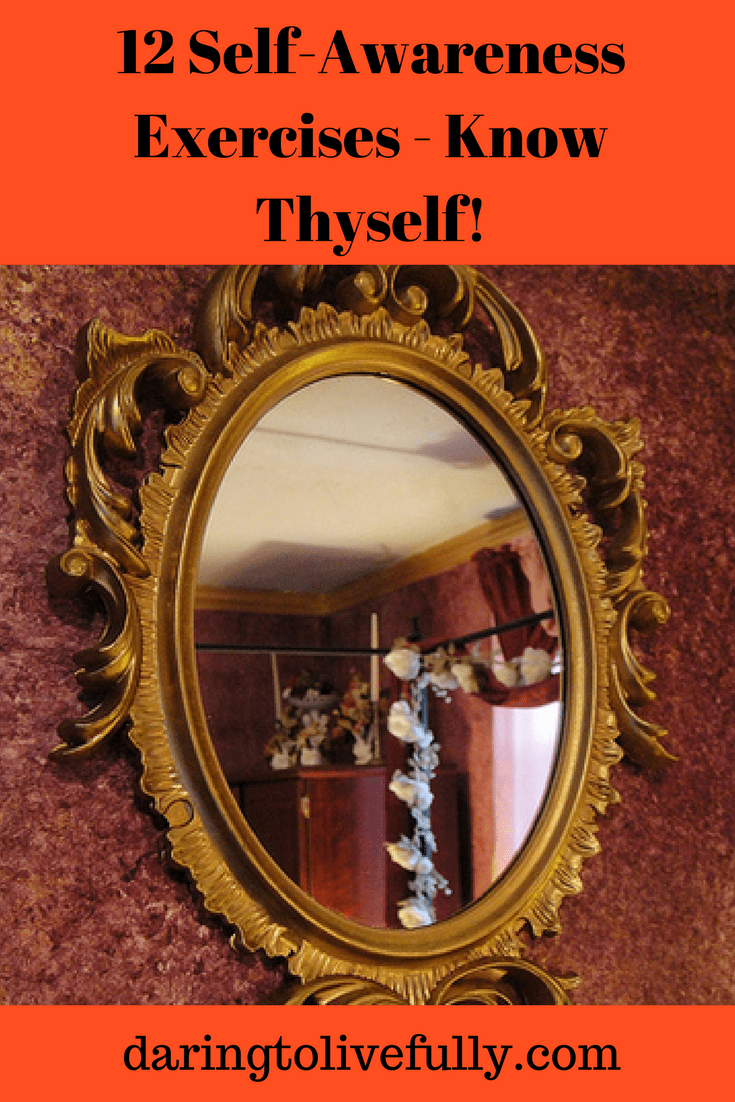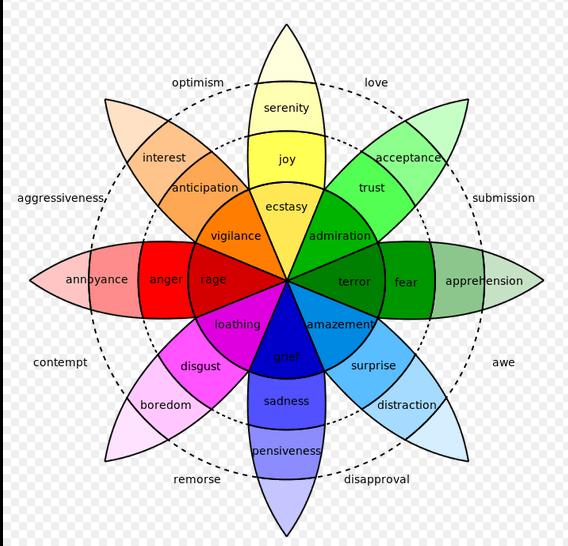
Self-awareness is the first step to self improvement.
Self-awareness is knowing what makes you tick. It’s understanding your own needs and desires, knowing what your strengths and weaknesses are, and being able to accurately assess your emotions. People who are self-aware know who they are at their core.
The way in which researchers determine whether babies and animals are self-aware is by putting a red dot on their forehead while they’re asleep or under anesthesia. They then place the animal or baby next to a mirror. The researchers then wait to see what happens when the subject that they’re studying wakes up and looks in the mirror.
If they touch the dot on their forehead—instead of touching the dot on the face in the mirror—then it’s determined that they’re self-aware. This is because the action of touching the dot on their face suggests that they understand that they’re looking at an image of themselves.
Clearly, you would instantly recognize yourself if you were to look in a mirror. But how well do you really know the person who’s reflected back to you? For instance, could you answer all the following:

- How does this person think?
- What does this person find meaningful?
- What is this person passionate about?
- What are their interests? What do they love to do?
- What are their beliefs (both empowering beliefs and limiting beliefs)?
- What are their values?
- What were they put on this earth to do?
- What emotions do they feel most of the time?
- What are they feeling right now?
- Why do they behave the way they do?
- Who are they underneath the socially constructed self that they’ve created in order to fit it?
- What impression do they create on others?
Chances are, you can’t answer most of these questions. After all, most people can’t. If you would like to become more self-aware, a great way to do this is by completing self-awareness exercises.
Below you’ll find 12 self-awareness exercises to help you to get to know yourself better.
1. Apply Feedback Analysis.
The Jesuits are a religious order of men within the Catholic Church. I wrote about the founder of this order– St. Ignatius of Loyola–in my post, What A 16th Century Priest Can Teach You About Self-Improvement.
Whenever a Jesuit makes an important decision, he writes down how he reached his decision, and what he expects will happen. Then, nine months later, he compares the actual results to what he had anticipated. This method allows the Jesuit to do the following:
- Notice what worked and what didn’t.
- Evaluate his decision making process.
- Notice any flaws in his cause-and-effect analysis and in how he’s reaching his conclusions.
- Apply the feedback and make better decisions in the future.
- The feedback analysis can also highlight competencies that the Jesuit need to develop further.
Warren Buffet also applies feedback analysis. According to the Harvard Business Review, when Warren Buffet makes an investment decision he carefully articulates the reasons why he’s making the investment. His journal entries serve as a historical record that helps him assess the accuracy of his investment decisions.
You can start applying feedback analysis in your own life in order to become more aware of how you’re making decisions, and how you can improve your decision making process. Start codifying your rational and motivations whenever you make an important decision, and then–about nine months later–reflect and assess the outcomes.
Increase your self-awareness by applying feedback analysis in your life.
2. Take Psychometric Tests.
Psychometric tests can help measure a person’s skills, numerical or verbal aptitude, or their personality type. Although the results of these tests shouldn’t be taken as gospel, they are a good way to start learning more about yourself and increase your self-awareness.
Here are three (free) psychometric tests you can get started with:
- The Predictive Index Behavioral Assessment – a science-based assessment that provides an accurate depiction, or pattern, of your core drives, and therefore insight into your needs and behaviors.
- The 16 Personalities Test – like the classic Myers Briggs Type Indicator (MBTI), your answers determine where you fall on four spectrums: extroverted/introverted, sensing/intuitive, thinking/feeling, and judging/perceiving.
- The Entrepreneurial Aptitude Test – this test helps you determine if you have what it takes to start a business.
3. Identify Your Strengths and Weaknesses.
One of the most important things you need to know about yourself is what your strengths are, and what your weaknesses are. This will allow you to focus on the first, and manage around the second.
Take a moment right now and write down the answer to the following question: “What are your strengths?” If you have trouble answering this question, you can find out by taking a strengths test. One option is the VIA Character Strengths Survey (free), or the StrengthsFinder test (not free).
In terms of your weaknesses, here are three tips for identifying the areas that need shoring up:
- Ask yourself which tasks you keep avoiding.
- Think back to your failures. Is there a common pattern to those failures? What weakness are those failures pointing to?
- Think back to every evaluation you’ve received, whether at school or work. Is there something that people keep telling you that you need to work on?
4. Ask People You Trust for Feedback.
When I was a kid in school, a popular prank was to tape a note to another student’s back. The trick was to do it subtlety so that the other kid didn’t notice that something was being taped to their back. The note usually said something like, “I’m stupid” or “Kick me”.
The joke was that the kid didn’t know that they had a note stuck to their back, but everyone else did. Our personalities are a little bit like this. We all have a blind spot: things about ourselves that we can’t see, but others can.
In addition, you can never be sure of how you’re coming across to others until you ask them. Therefore, if you want to become more self-aware, ask a few people you trust for feedback on your personality. Ask for both positive and negative feedback, as well as for any advise they may have on how you can improve.
5. Listen to Your Self-Talk.
Think of your thoughts as a river that you’re swimming in. Every once in a while, climb out of the river and sit on the river bank. Then, observe the river. Listen to it.
Write down what you hear the river saying. Try to copy what you hear word for word. If you do this two or three times a day for a few days, you’ll be creating a record of what your self-talk really sounds like. Then, read through your notes and you’ll become more aware of what you say to yourself all day long.
6. Keep Morning Pages.
If you want to become more self-aware, add Morning Pages to your morning routine. Morning Pages is an exercise introduced by Julia Cameron in her book, “The Artist’s Way” .
It involves three pages of long-hand stream-of-consciousness writing which is done first thing in the morning. For fifteen to twenty minutes, you simply write about whatever is on your mind.
As an added bonus, the psychological benefits of externalising thoughts via journalling are well-established. By keeping Morning Pages you’ll get to know yourself better, and give your immune system a boost.
7. Label Your Emotions.
Part of being self-aware is understanding your emotions. How do you feel right now? How many emotions have you felt in the last 24 hours? What is the most prevalent emotion in your life at the moment?
A lot of people have a very limited vocabulary when it comes to expressing what emotions they’re feeling, and this limits their ability to be fully aware of, and to fully comprehend, what they’re feeling.
If you get better at labeling your emotions, not only will you lead an emotionally richer life, but you’ll also be able to respond more appropriately to what’s happening around you.
One way to get better at labeling your emotions is by becoming familiar with the Plutchik Wheel of Emotions.

8. Have a Life Vision and Mission.
Are you just surviving, or are you living on purpose and working to create the kind of life that you want? People without self-awareness usually fall into the first group, while self-aware people fall into the second. A great way to start living your life on purpose is to create a vision and a mission statement.
A vision statement answers questions like the following:
- What will your legacy be?
- What will your life look like 20, 15, 10, and 5 years from now?
- What’s your North Star? What are you working to achieve over the long term?
A mission statement answers the following questions:
- What do I do?
- Who do I do it for?
- How do I do it?
Increase your self-awareness by creating a life vision and a mission statement.
9. Create a Personal Manifesto.
In my post, How to Write a Personal Manifesto, I define “personal manifesto” as follows:
“A personal manifesto is a declaration of your core values and beliefs, what you stand for, and how you intend to live your life.”
Become aware of–or identify– your core values and beliefs, and then describe how you intend to live in a way that honors those values and those beliefs. That’s your personal manifesto.
10. Fill Out Self-Exploration Questionnaires.
One way to become more self-aware is to ask yourself questions about yourself. You can get started with the Proust Questionnaire which will help you to uncover your life outlook and give you some insights into your inner workings. In addition, here are four more questionnaires you can try:
- 99 Powerful Questions to Ask to Turbocharge Your Life
- 20 Questions to Ask Yourself
- These 20 Questions Will Improve Your Awareness of Yourself
- 30 Journaling Prompts for Self-Reflection and Self-Discovery
11. Question Your Automatic Thoughts.
Oftentimes, our automatic thoughts are negative and irrational. People who lack self-awareness will often accept these thoughts as true, which distorts their perception of reality.
A self-aware person, on the other hand, is aware of the cognitive distortions that they have a tendency to fall prey to. This allows them to dispute irrational thoughts and replace them with better thoughts which more accurately reflect reality.
As an illustration, here are three cognitive distortions to watch out for:
- All-Or-Nothing Thinking: Seeing things in black-and-white. If your performance falls short of perfection, you see yourself as a total failure.
- Mental Filter: You pick out a single negative defeat and dwell on it exclusively so that your vision of reality becomes distorted.
- Disqualifying the Positive: You dismiss positive experiences by insisting they “don’t count” for some reason or other.
Here’s a list of 20 cognitive distortions you can refer to in order to become aware of your irrational thoughts.
12. Create a Bucket List.
What on earth does a bucket list have to do with self-awareness? Simple! Creating a bucket list can help you to identify what you want to be, do, experience, and have in life. And knowing all that will make you more self-aware.
Bonus: Take your bucket list and turn it into long-term, mid-term, and short-term goals.
Conclusion
People who are self-aware really know themselves. They know who they are, what they want, and why they act as they do. This allows them to intentionally create the life that is best suited for them. Live your best life by increasing your self-awareness.





Related Posts:




 Marelisa Fabrega is a lawyer and entrepreneur. She holds a Bachelor of Science in Business Administration from Georgetown University in Washington, D.C., as well as a Juris Doctor from the Georgetown University Law Center. You can learn more about her
Marelisa Fabrega is a lawyer and entrepreneur. She holds a Bachelor of Science in Business Administration from Georgetown University in Washington, D.C., as well as a Juris Doctor from the Georgetown University Law Center. You can learn more about her 





